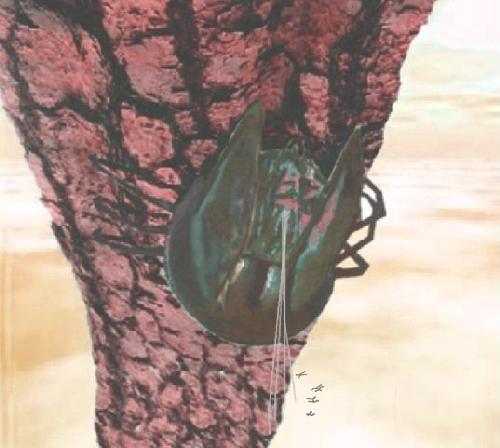BY LETTER
Honeywhip
 Image from Steve Bowers | |
| A Skunkwhip attracts a swarm of bipterid flies | |
The honeywhip gets its name from the sweet smelling strands, or whips, of sticky "silk" that it spins out from its body to catch its prey. Depending on the species, a honeywhip may produce anywhere from one to six strands of silk which it dangles from its body while hanging upside down from underneath a convenient tree limb. Each strand of silk is tipped with a drop of aromatic, but extremely sticky, fluid which it uses to attract the insect equivalents that inhabit the Trees ecosystem. When these creatures attempt to feed on the "nectar" on the tip of the strand they become stuck and are then further entangled in the silk by their struggles before being rapidly pulled into the honeywhips maw as it withdraws the strand back into its body.
The honeywhip is generally described as resembling a cross between a Terran king crab and a beetle. The creature possesses an armored body and six long, chitinous legs (generally extending three times the diameter of its own body) ending in hooks used to anchor it to the trees where it makes its home. Coloring is typically designed to provide camouflage in the creature's native environment. Along its back, where a crab would have a single continuous carapace, the shell is split into two halves that hinge outward like the wing cases on several species of Terran insect. When the honeywhip opens its shell it uncovers a set of sharp mouthparts and one or more spinnerets which it uses to produce its hunting silk.
Honeywhips come in a variety of sizes and species, ranging from the dwarf honeywhip, often called a miniwhip, of the northern arctic forests (leg span of 1 centimeters), to the elusive giant honeywhip (leg span of 1/3 meters) of the Wirali Archipelago. Two of the most famous honeywhip species are the rainbow honeywhip, which often hunts in flowering trees and is colored accordingly, and the so-called skunkwhip which uses scented strands that mimic the smell of rotting flesh to attract carrion eating prey.
The silk and 'honey' of the honeywhip are both produced naturally as a byproduct of the creature's digestive processes. Although it is not actually classified as a plant and is considered an animal life form, the honey of the honeywhip actually bears more of a chemical resemblance to the secretions of some varieties of Terran carnivorous plants than the sweet concoction its name is partially derived from.
Related Articles
Appears in Topics
Development Notes
Text by Todd Drashner
Initially published on 12 July 2007.
Initially published on 12 July 2007.






